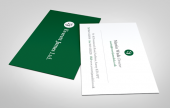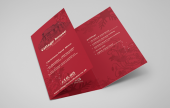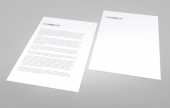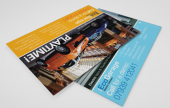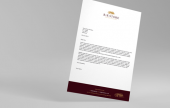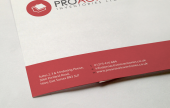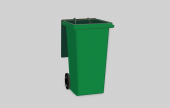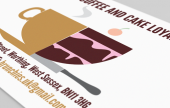What is Recycled Printing?
Author:
Jim Cunliffe
Published: 23/08/2013
Recycling is a wonderful thing to do, and as our natural resources become more scarce, it will become more and more compulsory in all areas of life. Recycling ranges from separating your garbage at home, to buying recycled toilet paper (no, they recycle it from regular paper, they don't fish it out of the sewerage!), to choosing to buy from companies which recycle and are environmentally responsible.
In some products and businesses, there is little difference in the end product between a company that recycles its products, does not use harmful chemicals, and employs other environmentally friendly tactics in its day to day operations. In others, though, there are differences ranging from unworkable to usable only in different markets. In the area of printing, a chemically-intensive process, there can be a difference in the end result between companies that use environmentally friendly supplies and processes and those that use conventional means. Which way you go - and what company you choose to deal with - depends on what you need from your finished product.
Lithographic Printing Explained
Lithographic printing is the main method employed currently for printing large quantities of a design on a flat medium. It was invented in Bohemia in the late 1700's - but has come a long way from its bohemian origins to be quite a chemically-intensive process.
Lithographic printing is based on the fact that oil and water do not mix - the areas of light and dark in a particular color in the process are created by using an "oily" ink to create the darker areas and varying amounts of water to repel the ink at the necessary light places on the medium. The ink must have a high lipid content to work properly in the lithographic print process. The image is drawn in this ink onto a print plate, and then an acid which is made into an emulsion with gum arabic is applied, which creates a layer of salts around the details of the image - where the ink is. After this, the printer uses lithographic turpentine to remove the ink, and leaves only the salt sheet to hold the detail of the image. During the print process, the stone or print plate has water constantly applied to it, which is attracted to the salt in the sheet. So when "oily" ink is applied to the surface, it collects in the depressions left by the original ink, being repelled by the areas where the water is. When enough ink is in the depressions, the paper and print plate are run through a press which transfers the ink to the paper by allowing it to soak in. Several sheets can be done with the same plate.
Lithography is an offset technique - meaning that the image is not directly applied to the paper, but goes through several media. It is collected on the printing plate, then transferred to a rubber blanket in modern lithographic printing, after which it is transferred to the paper.
In modern litho printing, photographic chemicals and principles are also employed. Photosensitive chemicals are used to create very detailed images - an emulsion with the image is created on the plate with these chemicals. This allows a lot greater variation within a color from light to dark shades, and a more reliable result. More common than this process, nowadays, is the use of direct laser imaging to create the image, in a device known as a platesetter.
Lithography, hugging trees
Lithographic printing up until recently has required chemicals to remove the non-image emulsion from the printing plates. Obviously, the more chemicals are used in a process, the more we have to take out of the Earth, either by mining them out directly or refining them in some way, typically with by-products which are useless and need to be disposed of somewhere... However, in the offset lithography process, water can be used again to create the negative image (light color areas). Water fell out of favour because with the water method, technical considerations made it difficult to print anything other than large areas of flat color. In offset lithography rollers apply water to cover the blank areas of the plate, and then ink is applied by other rollers to cover the emulsion. This is transferred to a rubber blanket to soak up excess water, so that the substrate is not ruined. Without the use of the offset medium, chemicals are necessary, as water cannot be used. However lithography since this development has been much more environmentally friendly.
Another, simple reason that lithographic printing is actually environmentally friendly is its efficiency and versatility. If something can be printed more quickly using a particular process, then the environment benefits because there is less electricity used. Hopefully then the extra time gained allows people to go home, and spend time either composting, recycling or planting trees, or thinking up innovations to our way of life to create even more environmental benefit!
Lithographic printing, shunning trees!
The necessity of using a high-lipid ink in the litho print process limits its environment-friendliness possibilities. There are a wide range of types of ink, but only some have high fat or oil contents. Petroleum based inks are the most commonly used types, and these have a high VOC content, or Volatile Organic Compound content. High-VOC content materials are ones which vaporise under normal conditions - they evaporate easily, or have a very low boiling point. Also, the use of petroleum-sourced inks is simply yet another process in which we are dependent on the mining of crude oil, to add to the fact that we need it in the production of electricity as a daily necessity and fuel for our cars, which are normally used daily.
Other impressions that high-VOC compounds have on the environment include the fact that they are difficult to dispose of safely, meaning that they are often disposed of unsafely. They can easily contaminate soil and groundwater, to add to the high risk of contacting chemicals that we already have in our daily lives. The fact that they vapourise easily under normal temperatures and atmospheric conditions means that if they are not stored properly, their vapours escape into the air and contribute to air pollution. When these products vapourise into the atmosphere, as well as just generally being not the sort of thing you want to breathe in (!), they also react with nitrogen oxides in the air and light energy form the sun to form ozone... although this gas is great in the upper atmosphere, VOCs do not make it this far up before they react. Lower down, it can cause respiratory problems in animals and humans, as well as damaging crops and buildings!
Briefly, when these inks are consistently used in printing, levels of VOCs in the printing area can sometimes reach up to 1000 times their normal level outside. The effect this has on your health is quite easy to imagine! They contribute to Sick Building Syndrome, where people working in a contaminated building suffer from asthma, skin, nose and throat irritation, non-antibiotic responsive bronchitis and pneumonia, and sometimes personality changes.
In lithographic printing it is preferable to use denser papers or coated papers; often recycled varieties of paper are more porous than paper produced directly from a tree. Of course, recycled paper can be bleached and coated, but then nearly all of its value is eroded by transforming it so. We said that litho printing requires high-lipid content inks - and we have all seen how oil soaks into paper and spreads when we get fish and chips from the shop. To prevent spreading and lower-quality printing, it is preferable to use non-recycled papers in litho printing.
Recycled Printing - the environment's choice
Recycled printing is not actually a process as such, more a replacement of various products in whatever printing process you use with recycled or recyclable products. So, in obvious contrast to the point above, recycled printing's main aim would be to used recycled paper where possible. Other printing processes make this easier to do than litho printing does. In recycled printing, the paper company's environmental philosophy and its location are also considered. The location is important in minimising the environmental impact of long-distance shipping - transport still basically requires petroleum products, whether it is by air, land or sea.
Another major aspect of recycled printing is the use of soy inks, which are produced using soybean oil and then the regular pigments that go into petroleum based inks. It takes about 0.5% of the energy that petroleum based ink takes to manufacture, to create the equivalent soybean ink. We are not taking precious oil out of the Earth... and also, climactic conditions mean that many soybeans grown around the world do not even need to be watered, which is inordinately helpful in these times of climate change and non-dependable rainfall.
Soy inks have a low percentage of VOCs, which we showed above have enormous impact on the health of our soil, water, air, and human bodies. Testing has shown that soy inks pose no threat to the air or environment. The fact that they take one two-hundredth of the energy to manufacture that petroleum-based inks do means that there are less emissions created in their manufacture, as well as simply by their existence.
Another benefit of soy inks is that they are easier to remove from paper during the recycling process than traditional inks are, so recycled paper is brighter and less contaminated. As soy inks often create a brighter result, less ink is needed for the same result, and on recycled papers with high contaminant content, they show up better.
Recycled printed products are usually created using digital printing methods, as opposed to standard older style methods, which almost always rely on chemicals at some stage. Digital printing does not require film or chemicals, supports the use of soy ink and recycled paper. In the digital print process, the ink or toner does not soak into the paper, like traditional ink compounds do - it forms a layer on the surface, which makes recycling easier again. Digital printing uses less energy and paper, can be used for smaller runs, supports "cleaner" products, and is basically the way of the future!
Recycled Printing - environmentally unfriendly?
It is difficult to find anything environmentally "unfriendly" about the methods recycled printing employs - after all, everything about it is designed to benefit the environment, sometimes at the expense of another aspect of the job - cost or quality, occasionally. Perhaps better ways of created recycled printed materials will emerge in the future - rendering the current methods worse for the environment - but for now, recycled printing gets three thumbs up!
To Conclude
Lithographic printing is still used for some jobs with very specific quality requirements. Fortunately though, as recycled printing becomes more common, economies of scale will be formed as well as technology improving, to allow us to print in environmentally friendly ways with exactly the same quality and efficiency as lithography or any other traditional method affords us. In the meantime, you can contribute to this development by choosing recycled printing products and processes, to help start the avalanche!


